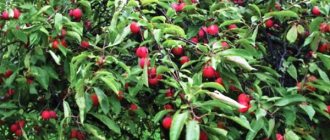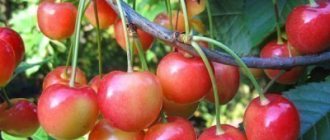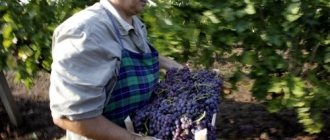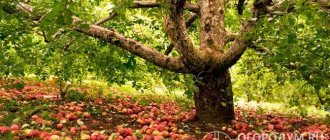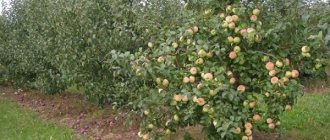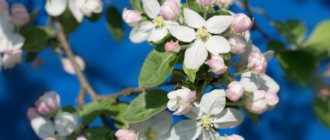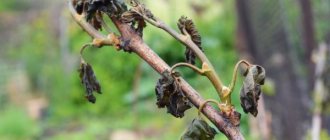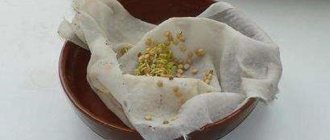When does an apple tree begin to bear fruit and what does it depend on?
After how many years can you see the first fruits? Each crop has its own fruiting properties. The fastest in terms of yield are some berry crops that bear fruit after 1 year. A plant with a seed (cherry, cherry, apricot) will begin to bear fruit in 3–6 years. The apple tree is a representative of the pome crop and produces a harvest no earlier than after 5 years.
The most optimal apple tree for early fruiting is the Welsey variety. This type of apple tree is characterized by regularity in increasing productivity annually. Dwarf varieties of seedlings are also distinguished by their early fruit bearing. Rapid fruiting is accompanied by dry, hot weather conditions during the development of the tree. Rainy and cloudy weather slows down the growing cycle.
How long does it take for cherries to bear fruit? Life cycle of a cherry, reasons why it doesn’t bear fruit
How many times does a cherry tree bear fruit in its life? In what year will cherries bear fruit after planting? How long does a cherry tree grow before fruiting? These and many other questions concern new agronomists.
Cherries, as a rule, begin to bear fruit 3-4 years after planting. Dwarf varieties are a little earlier. This time is required to build up the crown and root system of the tree. If cherries are grown from seeds, then you will need to add at least 2-3 years.
Cherry blossoms, but does not bear fruit
The main reasons why cherries do not bear fruit.
- Cherry diseases. A fruit tree may not begin to bloom and bear fruit if it is affected by coccomycosis and moniliosis. In the latter case, the tops of the shoots, young leaves, ovaries and fruits will begin to dry out, and when you see the branches, you get the impression that they are burnt. The disease is activated by excess humidity. Pronounced symptoms of pathology: the formation of numerous small spots of red-brown color; As they develop, the leaves turn yellow, curl and fall off.
- Planting a seedling in a bad place or poor-quality planting material. It is recommended to purchase seedlings from special nurseries, where there is no chance of purchasing sick, weak or damaged trees. As for location, all fruit-bearing trees need plenty of light. If the cherry grows in a sunny place, you should regularly expect abundant harvests.
- Increased soil acidity or nutrient deficiency. Cherries are not able to produce high yields when growing in acidic soils. Using a pH meter you can find out the acidity level of the soil. At high values, it is necessary to add lime to the soil.
- Inappropriate trees in the neighborhood. Cherry is quite picky in choosing neighbors. It will not bear fruit well if any representative of coniferous trees grows in the neighborhood. Also, cherries do not like the proximity of honeysuckle and apple trees. It is also better not to plant irises, pansies, lilies, daffodils and tulips nearby.
How to bring your fertile age closer
Not everyone has the iron patience to wait for fruit from an apple tree that is planted. Breeders adhere to proven growing methods. Careful care and pursuit of the set goal bring the harvest time closer much faster. The first fruits are rapidly formed using intensive agricultural techniques, such as:
- Biological. The method is based on the cultivation and breeding of varieties with new properties.
- Chemical. The use of maturation-stimulating substances has been used in practice for a long time. The peculiarity of the method is to slow down the growth of the plant upward and thicken the branches.
- Spraying method. Fungicide "DNOC" is diluted with water in a ratio of 1 gram to 1 liter. This drug destroys the flower ovary. It is effective on buds that have fully blossomed. The substance does not interfere with bee pollination.
The simplest mechanical method is considered to be the method of bending branches. The buds awaken due to the tendency of the largest branches towards a right angle. The gestation of fruits begins to accelerate and the growth process slows down. The length of the branch determines the number of ovaries.
In addition to bending, there is a ringing method. You need to remove the bark from the branch, turn it over to the other side and secure it in the shape of a ring at the previous location. Photosynthesis with this method is limited and its products are redirected from the foliage and root system to budding.
The wire is used for the constriction method, which involves inhibiting the downward outflow of juice substances.
Frequency of fruiting
The annual fruit production of apple trees is the dream of every gardener. Some apple varieties form a limited number of fruiting ovaries. A stable harvest depends on the correct formation of the crown, timely pruning and abundant watering.
Experts in traditional growing methods have achieved annual yields. The unnecessary ovary is eliminated, thereby normalizing the number of inflorescences and ovaries. Each year, different parts of the apple tree must undergo the process.
Due to the accumulation of useful substances for the coming harvest, this very “periodicity” is created.
Nature sometimes creates unfavorable factors for the development and ripening of fruits. These include the presence of:
- Frosts that destroy buds and flowers.
- A cold and rainy summer followed by a winter with little snow. It is in the summer that the ripening process occurs.
- Species and varietal diseases.
- Massive invasion of parasites.
- Lack of nutrients.
Video “How and with what to fertilize fruit trees”
From this video you will learn how to properly fertilize fruit trees.
Gardeners manage to find ways to make the apple tree bear fruit a little earlier, but after planting it still takes time for the tree to begin to bear fruit. Also, the correct choice of variety can contribute to the speedy appearance of apples. There are varieties of fruit trees that have a faster growing season. Among them are the following.
- The “folk” apple tree has medium-sized fruits, which are distinguished by a yellow-golden color, have a rounded shape and a sweet taste with a pleasant sourness and a sugary, spicy aroma. Apples reach maturity in late August - early September, so the variety is considered early ripening. The advantage of this variety is that fruiting begins already in the second year after planting. True, it’s a little sparse, but you can see a few fruits per season. Every year the yield increases.
- The Zhigulevskaya apple tree has very large golden-colored fruits with red splashes on the sides. The apples ripen in September, have a round shape with a flat top and bottom, and their taste is sweet and sour. Such an apple tree begins to bear fruit and bear fruit already in the fourth year after planting. In the eighth year of growth, the crop is characterized by particularly high yields, starting to produce up to twenty kilograms of apples per season.
- The lingonberry apple tree ripens in October and has bright red, elongated fruits. Their weight usually does not exceed one hundred grams. This variety begins to bear fruit in the third year after planting. Also, the advantage of such an apple tree is that it is suitable for cultivation even in areas that are not the most favorable for growing this crop (Yaroslavl, Vladimir, Tver). The variety is frost-resistant, the yield is stable.
The above varieties are the most suitable for cultivation in Russia and surrounding countries. Also no less successful would be the choice of varieties such as “white filling”, “borovinka”, “renet”, “krasa”, “Volzhskaya”, “candy” and others. After planting, such apple trees bear fruit no later than in the fourth year. With proper planting and regular care, the crop may begin to bear fruit a little earlier than usual.
What are phenophases and why do gardeners need them?
After the dormant period comes the growing season . At this time, leaves, shoots, fruits grow, and new buds form. For convenience, the growing season is divided into several shorter periods of time, during which some particularly important changes in the condition of the plants occur. These segments are called phenological phases or, in short, phenophases. As an example, we give the most important phenophases of the apple tree:
- bud break - covers the period from the beginning of bud break to the formation of rosettes of leaves;
- flowering - the beginning is the date when 5% of the flowers bloomed, and the end is the date when the petals from 90% of the flowers fell off;
- shoot growth - covers the period from the beginning of the blooming of vegetative buds to the formation of the apical bud on the shoot;
- setting, growth and ripening of fruits - the period from the end of flowering to the onset of removable fruit maturity;
- laying and differentiation of generative buds - the beginning of this phenophase is not visually determined, therefore it is timed to coincide with the end of shoot growth. Bud differentiation does not have time to be completely completed before the end of the growing season. At some stage, when the tree enters the dormant period, it stops, and then continues again in the spring;
- leaf fall - this phenophase lasts from the beginning to the end of leaf fall;
- the end of the growing season and the entry into dormancy - the beginning of the phenophase occurs at the end of leaf fall, and the end - at the cessation of growth of active roots. Naturally, it is difficult to establish the end of this phenophase. Sometimes the leaves get caught in the frost and remain hanging on the tree until mid-winter, or even longer.
Observing phenophases is not only an interesting activity, but also a useful one. Most work in the garden, including various pruning techniques, give the greatest effect if they are confined to certain phenophases.
How to speed up the fruiting process?
You can speed up the process of fruit appearance at home with simple steps. There are two ways in which you can speed up the fruiting process without damaging the tree.
The chemical method involves feeding or spraying apple trees with special solutions or chemical fertilizers that stimulate the vegetative process and accelerate the appearance of fruits. The physical method involves a series of actions that allow you to “outwit” nature and force the tree to bear fruit earlier by influencing its trunk and branches. Our article describes several proven methods that will definitely help speed up the appearance of fruits.
Bending down branches
Bending down the branches of a tree is a completely safe way to speed up its growing season. The method is to increase the angle of inclination of the branch, which will accelerate its growth and, accordingly, the speed of fruit appearance. The process itself looks like this:
- in the spring, several branches are selected that are thin enough to bend, but strong enough not to break when bent;
- a strong spacer is installed between the branch and the trunk, which will tilt the branch in the other direction;
- Additionally, you can tie a strong rope to the branch, the other end of which can be tied around the tree trunk closer to the ground;
- In summer, the support and rope can be removed.
With this method, the main thing is not to overdo it and not break the branches. This option is only suitable for relatively young trees, since old ones have too hard wood that cannot be bent without damaging the apple tree.
Pinching
Pinching is an excellent way to speed up the start of fruiting of an apple tree, but it is only suitable for young seedlings whose wood is not yet strong enough.
The method is as follows: when the seedlings reach a height of twenty-five centimeters, it is necessary to pinch the tops of the shoots so that about three leaves remain from the trunk. Because of this, the tree has to spend a lot of effort on ripening the branches, due to which the fruiting process becomes faster.
This method is very simple, but the effect of it can only be seen two years after planting the tree.
Banding
The ringing method is suitable not only for young but also for mature trees. It consists of selecting several fairly thick and strong branches, winding a strong wire at their base and using pliers to twist it using the rope technology. To avoid damaging the bark, be sure to place a soft cloth under the wire. The puff must be left for two months and then removed.
How many years will it take for the apple tree to bear fruit if you use this method? The speed of fruiting will increase significantly, and you will get your first harvest within a year.
By following all the necessary rules for caring for fruit trees, as well as following our recommendations, you can speed up the fruiting of your apple tree and get a large and high-quality harvest much faster.
Advice from experienced gardeners
The beauty of a blossoming apple tree is a picturesque sight. It refreshes in the heat, protects from the scorching rays of the sun, creating a saving shade. Covered with ripening bright fruits, it looks picturesque in the garden. Surprisingly with a variety of flavor notes.
To see it like this every year, you need to look closely at the behavior of the plant in different conditions. Help to recover, cherish, care for the apple tree.
Pruning must be done at least once a year to balance the processes of growth and fruit formation. Depending on the region of cultivation, when the temperature rises closer to +10° C and the woody parts become more flexible, but sap flow has not yet begun, the tree is prepared for the season. The average time is mid-March. Removed:
- Old, highly branched fruit formations. Young branches that replace them are more likely to produce strong apples.
- Processes of the central conductor. Shortening will save and redirect juices to life support.
- Shoots growing vertically. They are cut off at the base.
- Branches blocking the light. By thickening the crown, they limit the flow of heat, air movement, and prevent it from developing to its full potential.
- Thick non-working branches. They are sawed off first from the bottom, then along the top side. The saw cuts are treated and coated with garden varnish, RanNet disinfectant garden mixture, etc. for rapid healing.
Apple trees shorten their fruiting periods by annually digging up trunk circles with a radius of about 1 m. First, the soil is cleared of plant residues and debris. Treated with a prophylactic solution of iron sulfate (3%). Water abundantly, 30–40 buckets for each trunk. Mulch with sawdust, earth, compost in a good layer, from 0.2 m. The bases of the branches and the trunk are whitened, wrapped in burlap or other improvised, air-permeable material to prevent rodents. The tree is warmed by a pillow of snow around the trunk.
With the onset of bright spring days, the tree is freed from its “clothes”. The mulch layer is turned up, but not removed; it retains moisture all season, warming during the day and cooling at night. The root system receives moisture from condensation even at very high air temperatures.
In order to force apple tree seedlings to begin bearing fruit earlier, the planting area is seasoned. A hole at least half a meter deep and 1 m in diameter is filled with rotted manure (4 buckets) mixed with wood ash (1 kg) and superphosphate (0.5 kg). Soil is placed on top, first black, fertile, then light (sandy, clayey). It all depends on the quality of the soil. Fertilizers are not needed in the first year.
In conclusion, a little trick for a big gardener: you can check whether the apples are ripe or not ready for harvesting and storage in a simple way.
Pick the fruit, cut it and drop in regular iodine. Reacting with starches, the spot turns black after 1–2 minutes, which signals insufficient ripeness. In ripe apples, iodine does not change color.
How many years does an apple tree bear fruit - a favorite among fruit trees
It's hard to imagine a garden without apple trees. I decided to plant trees on my site, but their lifespan turned out to be short-lived. Diseases and a twisted crown, broken branches - this is not the whole list of misfortunes that befell my head. I had to urgently look for information: how to save fruit trees.
Two questions that I was looking for an answer to: how long does an apple tree live in the garden, and how can you extend its life? I still remember the days spent in my grandmother’s garden. There grew large, perennial giants that were given apples every year. Since childhood, I remembered the variety of apple trees – Streifling. He remained loved for the rest of his life.
In my garden I tried to create conditions for growing fruit trees. In the article I tell you everything about the apple tree so that I know about it, as they say, inside and out.
What branches does your apple tree bear fruit on?
In order to avoid losing the next year's harvest when pruning an apple tree in the fall, you need to know on which branches most of the fruits are located. According to the type of apple tree varieties that bear the bulk of the harvest, they are conventionally divided into 5 groups.
The first group includes apple trees that bear fruit mainly on the ringlets. These are Grushovka Moscow, Borovinka, Papirovka, Bessemyanka, etc. This type of fruiting is inherent in plants with good bud awakening and poor shoot-forming ability. Their crown frame is strong and the lighting is good. But, unfortunately, with this nature of fruiting, periodicity is most likely.
The second group is plants that bear fruit mainly on spears and partly on fruit twigs and ringlets (Babushkino, Bellefleur-Chinese, Pepin London, Renet Simirenko, etc.).
The third group consists of varieties that bear fruit at the ends of vegetative type branches and partially on fruit twigs. These are Cinnamon striped, Golden Chinese, Korobovka, Renet bergamot, Aport. Bud awakening in trees of these varieties is poor. Trees are prone to developing long, bare branches. There are many sharp forks and sharp corners in the crown, which is fraught with fractures.
The fourth group includes varieties with a mixed type of fruiting, i.e. fruiting on ringlets, and on spears, and on fruit twigs, and at the ends of branches of the vegetative type. These are Melba, Slavyanka, Pepin saffron, Autumn striped, Antonovka vulgaris, etc. Bud awakening and shoot-forming ability in trees of these varieties can be from average to very high. Therefore, their crowns are capable of becoming very thick. But fruiting is usually regular.
The fifth group includes varieties of small-fruited china and varieties in the origin of which Siberian and plum-leaved apple trees took part. They are characterized by lateral fruiting. This means that the predominant part of the fruit buds is laid in the axils of the leaves of strong shoots. Some of the harvest also occurs on ringlets. But ringworms usually do not live long.
The harvest, as a rule, of plants of this group of varieties is concentrated on the periphery of the crown. The awakening capacity of the buds is very high, and the shoot-forming ability is low. The frame of the crown is strong. The lateral type of fruiting can also appear in many large-fruited varieties - Welsey, Melba, etc. This property is one of the indispensable conditions when choosing varieties for cultivation as a meadow garden.
Apple tree in nature
The fruit tree is as old as humanity. Wild apple trees had small fruits. The ancestor is the Sievers apple tree. The first mention is associated with Central Asia. In Rus', only under Yaroslav the Wise did they begin to grow varietal trees.
The apple tree is easily recognized by its rounded leaves, pubescent on one side. In spring, the trees put on a snow-white outfit, only some varieties are self-pollinating, others need help in the form of neighboring trees of the same fruiting period.
The apple tree can be up to 8 meters high. A crop grown on a dwarf rootstock barely reaches a height of 4-5 meters. Different varieties tolerate frost differently and have special immunity to disease. The advantage of a fruit tree is its fruit. Apples ripen in summer, and winter varieties are stored until spring. Each variety has its own taste, fruit color and invariably contains useful substances. Apples contain the most pectin and iron.
So, how many years does an apple tree bear fruit in central Russia? It turns out that a tree, with proper care, can easily overcome the century mark. Wild species reach 150 years of age. They bear fruit throughout their life, but over the years the yield decreases.
Note! Each variety has its own fruiting curve. Therefore, before planting trees in a garden plot, you need to study the characteristics of the selected variety.
Botanists believe that in southern latitudes the lifespan of the apple tree increases. This is due to the climate. In Siberia, the exhausting cold and short summer affect the tree, which wears out faster.
Another factor that influences age is how early the tree began to bear fruit.
- Some trees. being young, they are ready to give apples. But the strength is not enough, and sometimes the tree wears out.
- A mature tree with a developed crown and root system is ready for achievements. With a large harvest, the branches can withstand the weight of the apples, and the tree itself is able to provide nutrients to the fruits.
Apple tree that does not produce crops
By understanding the existing situations of lack of fruit, you can identify the problem. Once the problem has been identified, the gardener only has two steps to take: destroy the cause of the lack of fruiting and wait until the next season, when the long-awaited apples can be tasted.
Possible reasons
The apple tree does not bear fruit
The easiest way to answer the question is why the apple tree blooms but does not bear fruit. In this situation, the area of causes is quite narrow, so any experienced gardener will be able to give beginners a lot of useful tips on identifying and eliminating the problem.
So, if a young apple tree does not bear fruit or produces poor harvests, you should first of all pay attention to secondary signs that play a much larger role than it might seem at first glance.
Complete absence of fruiting
If a productive early variety is planted, but all the deadlines for the first fruiting have passed, but there are still no apples, it means that the planting was done incorrectly. It is very important to observe many factors that can play a negative role in determining the yield of a young tree. Among them are the following:
- unsuitable soil characteristics;
- groundwater is too close to the root;
- the root collar is very rough;
- the trunk is deformed: bent or tilted;
- There are many drafts or a cold wind blowing at the landing site.
Even one of the listed problems can lead to a lack of harvest on time, delaying it for several years. They can be solved in various ways, including transplantation.
How to increase the fruiting period and productivity of apple trees
For gardeners, it is important that the tree does not grow easily on the site for a long time, but it also provides benefits in the form of an annual harvest. Even fruiting once every two years suits summer residents. In many ways, the period measured by nature depends on the variety, and secondly, on the conditions.
The first fruits appear on the apple tree at 3-5 years. Every year the yield increases. In reality, a tree exhausts its resource in 20-40 years. On my site this is primarily due to improper pruning of the tree. Therefore, I will pay special attention to this common mistake of gardeners.
But before giving advice, I advise you to watch the video. Visual recommendations will help you get an apple harvest every year:
Proper apple tree care
Correct fit
To grow an apple tree, I choose a illuminated area. I plant trees at a distance of 3 meters from each other.
If the groundwater level is high in the area, I plant a seedling on an artificial hill or choose the highest place in the garden. When planting, I dig a deep hole and cover the roots with fertile soil: humus and wood ash.
Trimming
The branches must receive enough light. The dense crown shades. Another disadvantage of not pruning is the large waste of energy and nutrients in maintaining leaves and ripening fruits.
Important! Timely and competent pruning forms the correct shape of the tree.
If this is not done, the tree will grow crooked and one-sided. The overweight will later be reflected in the breaking off of branches, and it’s not aesthetically pleasing.
Fertilizer application
I fertilize not only in the spring, but also in the summer. Gardeners divide fertilization into three stages.
- The first feeding is needed in the spring after the snow melts. The tree will be grateful for organic matter and complex mineral fertilizer, for example, nitrophoska or azofoska.
- It is useful to make the second application of fertilizers in June. I feed with a solution of green fertilizer and also add wood ash, which I use to pollinate the lower part of the trunk, blocking the path of pests.
- The third mineral fertilizing is necessary in July during fruit formation.
Note! Proper nutrition of the apple tree in summer becomes the key to the harvest for the next year. At this time, the formation of buds occurs. Be sure to fertilize and water!
I usually feed the apple tree at the same time as other crops, so no additional effort is required.
Pest Control
In spring, tree trunks turn white. Throughout the season I make sure that the tree trunk circle is free of weeds. If necessary, I treat trees with chemicals.
Yield rationing
Few people know that the formation of fruits on a tree cannot be left to chance. This statement applies not only to young trees that begin to bear fruit, but also to adults. If there is a large formation of flowers, some of them are removed manually. If I didn’t make it in time for flowering, then I work with the ovaries.
Young trees can tear when producing a large number of apples. What is a joy for a gardener, is a load on the branches and the entire plant for the crop.
I also regulate adult apple trees in the formation of fruits. The gardener must understand how difficult it will be for the tree to cope with a large number of fruits. Often such trees shed excess ovaries on their own.
Important! Mechanical removal leaves one central flower.
How to make an apple tree bear fruit every year
Traditional fruiting once every 2 years is, in fact, a simple biological phenomenon based on the physical lack of strength to lay fruit buds from period to period. After all, the apple tree spends 15 times more nutrients on flowering and formation of fruits, or rather seeds, than on creative processes - the growth of leaf mass and annual growth of shoots. Therefore, in order to achieve an annual harvest, gardeners should pay attention to the strengthening and correct implementation of certain agrotechnical measures.
These include:
- Apple tree pruning . Fruit plantings can significantly reduce fruit bud set due to low light levels caused by dense canopy or crowded planting. It is necessary to independently stimulate the development of young branches and shoots by trimming skeletal parts that have stopped growing. It is recommended to shorten them above the first strongly developed lateral branch, which will encourage it to grow.
- Feeding . The regular formation of fruit buds largely depends on the amount of annual growth, since the terminal shoots increase the activity of sap flow throughout the skeletal branch. But for this, the tree needs good nutrition and abundant watering.
For fruit crops, spring fertilizing with nitrogen fertilizers is especially important, which promotes the formation of ovaries. They must be added together with phosphorus and potassium in three stages: before flowering, after it and during the period of fruit filling.
- Yield rationing . This technique involves mechanical or chemical removal of excess flowers and ovaries. It is considered the most reliable in terms of inducing apple trees to bear fruit annually. It is carried out by thinning the crown and shortening the skeletal branches before the flowering period begins. You should also remove excess fruits.
The best results for achieving annual fruiting of apple trees are obtained by removing flowers. Only the central one should be left in the inflorescence, and the weak side ones should be removed. The method is extremely labor intensive, since thousands of units must be removed.
